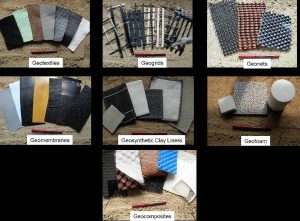Geosynthetics are products used to separate, reinforce, filter, drain and contain terrain. They are made of synthetic polymers and come in the following forms: geotextiles, geogrids, geonets, geomembranes, geosynthetic clay liners, geofoam, geocells, and geocomposites. Because they do not biodegrade as easily as natural materials do, they are more stable and longer-lasting when used underground.
Geotextiles are flexible porous fabric made of synthetic fibers such as polypropylene or polyester. They are used for erosion control and to strengthen the soil on slopes. In combination with steel fencing, they can contain construction debris during demolition. Geotextiles can also be used to filter pollutants from stormwater run-off.
Geogrids and geonets, as their names imply, are grid- and net-like structures formed from polymers. Geogrids can be made from polyester, polyvinyl alcohol, polyethylene, or polypropylene. Geonets are made from polyethylene resin and are often laminated with geotextiles. Geogrids are used as reinforcement materials and geonets are used for drainage of liquids and gases.
A geomembrane can be made from one of several types of polymers. It’s a low permeability synthetic liner or barrier used to contain liquids or gases. Since the 1980s, this type of geosynthetic has been used to line solid-waste landfills. Geomembranes are also used as liners for secondary containment of underground storage tanks, golf course water holes and sand bunkers, water and waste conveyance canals, heap leach pads, and fish and shrimp ponds in the aquaculture industry.
Geosynthetic clay liners consist of thin layers of factory-fabricated bentonite clay in between two layers of geotextiles or bonded to a geomembrane. They’re used to retain seepage within a landfill.
Geofoam consists of processed polystyrene. The foam has many closed cells filled with air. Geofoam is 98% air by volume. It’s formed into large, lightweight blocks used as filler below a highway, bridge approach, embankment or parking lot. Geofoam can minimize settlement and reduce the weight on underground utility lines thereby minimizing the chance of collapse. Because of its insulating properties, installing it under pavement can minimize or eliminate the damage caused by frost heave. Geofoam is also used for retaining structures and slope stabilization to minimize the likelihood of landslides.
Geocells, also known as Cellular Confinement Systems, are honeycomb-shaped structures. The cells can be filled with sand, soil, rock, gravel or concrete depending on the project. Geocells limit the movement of the material while maintaining its compaction. This structure allows for the distribution of loads over a wider area. They’re used for reinforcing soft or uneven soil foundations and for stabilizing steep slopes. Because the cells allow for the passage of water, nutrients, and organisms through the soil, plant growth is possible. The plants’ roots then provide even more stability to the soil.
Geocomposites are combinations of geotextiles, geogrids, geonets, and/or geomembranes fabricated into a single unit. What materials are combined will depend on the purpose for which the end product will be used. For example, geotextile-geogrid composites provide separation and filtration functions, and drainage is improved in comparison to using geotextiles alone. One use for this type of geocomposite is to intercept and convey leachate in landfill liner and cover systems.
Today’s market size shows the worldwide revenues for geosynthetics in 2018 and projected for 2026.1 Geotextiles commanded the highest market share in 2018, more than 30%, followed by geogrids and geomembranes. Over this time period, growth will come from the construction and mining industries. Increased infrastructure spending on roads, bridges, railways, airports, and harbors in the United States, Germany, Poland, the United Kingdom, Russia, Australia, and India will increase demand for geosynthetics. In the mining industry, geosynthetic materials are used for creating waste barriers for mining by-products. Around 40% of global geomembrane production is used in the mining industry.
North America, whose revenues totaled $10.27 billion in 2018, is expected to continue to have the largest market share over this time period due to increased mining operations in the United States as well as ongoing infrastructure projects. Europe is expected to be the second-largest market as a result of the growing demand for residential buildings. Also, strict regulations relating to industrial waste management in Germany are expected to increase demand for geomembranes. The Asia-Pacific region is expected to see substantial growth as disposable incomes rise and the government invests more in industrial and commercial construction projects. Some leading global manufacturers of geosynthetics include Solmax, TenCate Geosynthetics Asia Sdn Bhd, TENAX SPA, Fibertex Nonwovens A/S, Tensar International Corp., HUESKER, Strata Systems Inc., ASRU AMERICA Inc., Global Synthetics, and Terram Geosynthetics Pvt. Ltd.
1 Due to the COVID-19 pandemic, many industries across the world ceased operations, at least temporarily. The source’s projections were compiled before this disruption. Because of this, the data may be revised in the future.
Geographic reference: World
Year: 2018 and 2026
Market size: $27.16 billion and $45.25 billion
Sources: “Geosynthetics Market Size, Share and Industry Analysis, by Product (Geotextile Geogrid, Geonets, Geocells, Geofoam, Geosynthetic Clay Liner, Geocomposites), by Application and Regional Forecast 2019-2026,” Fortune Business Insights Summary, March 2020 available online here; “Geosynthetics,” Wikipedia, November 24, 2019 available online here; “Geotextile,” Wikipedia, December 19, 2019 available online here; “Geogrid,” Wikipedia, March 1, 2020 available online here; “Geonets,” Wikipedia, November 27, 2019 available online here; “Geomembrane,” Wikipedia, November 24, 2019 available online here; “Geosynthetic Clay Liner,” Wikipedia, March 1, 2020 available online here; “Geofoam,” Wikipedia, March 1, 2020 available online here; “Cellular Confinement,” Wikipedia, January 16, 2020 available online here; “Geocomposite,” Wikipedia, November 27, 2019 available online here; “Solmax-GSE Becomes Solmax,” Solmax Press Release, February 11, 2019 available online here.
Image source: Geosynthetic Institute, “File:Geosynthetics1.jpg,” Wikimedia Commons, April 12, 2009 available online here.
Editorial Code and Data, Inc.
An editorial subcontractor for projects large and small.

